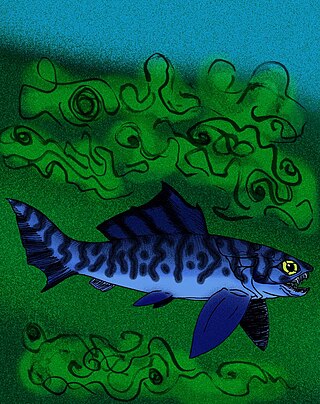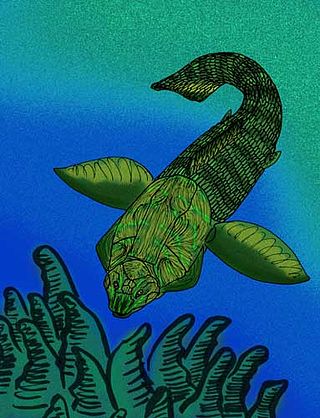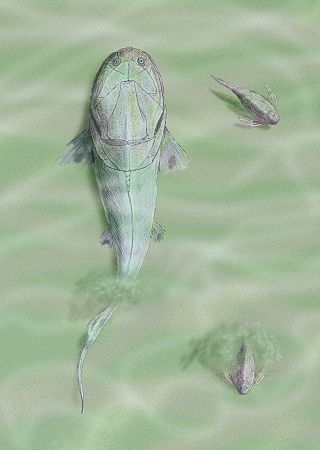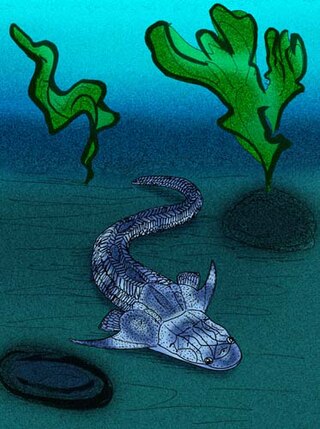
Placoderms are vertebrate animals of the class Placodermi, an extinct group of prehistoric fish known from Paleozoic fossils during the Silurian and the Devonian periods. While their endoskeletons are mainly cartilaginous, their head and thorax were covered by articulated armoured plates, and the rest of the body was scaled or naked depending on the species.

Arthrodira is an order of extinct armored, jawed fishes of the class Placodermi that flourished in the Devonian period before their sudden extinction, surviving for about 50 million years and penetrating most marine ecological niches. Arthrodires were the largest and most diverse of all groups of placoderms.

Petalichthyida is an extinct order of small, flattened placoderm fish. They are typified by their splayed pectoral fins, exaggerated lateral spines, flattened bodies, and numerous tubercles that decorated all of the plates and scales of their armor. They reached a peak in diversity during the Early Devonian and were found throughout the world, particularly in Europe, North America, Asia, South America, and Australia. The petalichthids Lunaspis and Wijdeaspis are among the best known. The earliest and most primitive known petalichthyid is Diandongpetalichthys, which is from earliest Devonian-aged strata of Yunnan. The presence of Diandongpetalichthys, along with other primitive petalichthyids including Neopetalichthys and Quasipetalichthys, and more advanced petalichthyids, suggest that the order may have arisen in China, possibly during the late Silurian.

Quasipetalichthys haikouensis is the type and only known species of the extinct petalichthid placoderm, Quasipetalichthys. Fossil remains of Quasipetalichthys have been found in the Middle Devonian, Givetian faunal stage of China.

Rhachiosteus is an extinct monospecific genus of arthrodire placoderm from the Middle to Late Devonian of Germany. It is known only from a single specimen, which may be a larval or juvenile form, as the skull of said specimen is only 19 millimetres long.

Selenosteidae is an extinct family of small to large-sized arthrodire placoderms from the Late Devonian. With the exception of the Chinese Phymosteus, selenosteids lived in shallow seas in what is now Eastern North America, Eastern Europe, and Northeastern Africa.

Hadrosteidae is a family of arthrodire placoderms from the Late Devonian. It was originally erected for the late Frasnian Hadrosteus, from the Kellwasserkalk facies. Later, the family was subjectively subsumed into Dinichthyidae due to Hadrosteus' anatomical similarities with Dunkleosteus and Dinichthys. In 1967, Obruchev placed the enigmatic arthrodire incertae sedisDiplognathus, from the Eastern American Famennian, within Hadrosteidae, on the basis of how the two genera have similar denticle ("teeth") patterns of the inferognathals, though, Denison (1978) contests this placement. With the redefining of Dinichthyidae as a monotypic family for Dinichthys, and only a few other genera placed within Dunkleosteidae, Hadrosteidae is now seen as a valid family again.

Hadrosteus is an extinct monospecific genus of large arthrodire placoderm from the Late Frasnian Kellwasserkalk facies of Bad Wildungen, Germany. It had large, double-pronged inferognathals, and serrated edges along its mandible, strongly suggesting that it was a fish-eating predator. The head had a triangular snout, and the trunkshield was short, but high, with a median dorsal plate that was broader than wide. The average skull length is about 16 centimeters.

Stenosteus is an extinct monospecific genus of medium-sized selenosteid arthrodire placoderms of the Late Devonian period known from the Upper Famennian Cleveland Shale of Ohio. Estimated skull lengths range from 6 to 9 centimeters Most fossils of Stenosteus have been scraps of armor and portions of tooth-plates suggestive of Selenosteus. In 1996, enough material of a new species, S. angustopectus, was recovered to allow a reconstruction of armor that resembles that of Selenosteus.
Erromenosteus is a genus of extinct, medium-sized brachythoracid arthrodire placoderm from the Late Frasnian of the Kellwasserkalk facies of Late Devonian Bad Wildungen and Bicken, Germany.

Pachyosteus is an extinct monospecific genus of medium-sized selenosteid arthrodire placoderm known from the Upper Frasnian Kellwasserkalk facies of Late Devonian Bad Wildungen, Germany and from the Famennian portions of the Holy Cross Mountains of Poland. The type species Pachyosteus bulla has a broad skull about 7 to 10 centimetres long, a comparatively long median dorsal plate, and a short rostral plate that meets the pineal plate.

Diplognathus is a genus of arthrodire placoderm from the Late Famennian Cleveland Shale of Late Devonian Ohio, known only from incomplete fragments of jaws and skulls. What fragments are known suggest that the living animals were large-eyed piscivores with weak, but widely gaping jaws. D. mirabilis is thought to be fairly large, with infragnathals up to 45 centimeters in length. The second species, D. larfargei, was much smaller, with inferognathals averaging about 4 centimeters in length.

Holonematidae is an extinct family of relatively large arthrodire placoderms from the Early to Late Devonian. Almost all fossil specimens are of armor fragments, though, all have distinctive ornamentation, often of unique arrangements and patterns of tubercles, that are diagnostic of the family. The trunkshield is very elongated, giving the armor an overall "barrel" like appearance.

Nessariostoma granulosum is a lightly armored pseudopetalichthyid placoderm from the Hunsrückschiefer Lagerstätte of Early Devonian Germany. The type and only known specimen is an articulated, but very incomplete individual, deformed and elongated, consisting of a large, incomplete, tubercle-covered head, a long, beak-like rostrum, and some of the trunk, with a total length of 18 centimeters. N. granulosum was once placed in Stensioellida, though most other experts regard it at as a pseudopetalichthyid: Denison 1978 regards it as a placoderm incertae sedis because the specimen is deformed and so poorly preserved so as to stymie proper attempts at classification.

Quasipetalichthyidae is a family of primitive petalichthyid placoderms from Givetian-aged marine strata of Yunnan, China, and possibly Vietnam. The family contains two confirmed genera, Quasipetalichthys, and Eurycaraspis, which differ from the more advanced macropetalichthyids by having more squared skulls that have the eye sockets placed on the side of their skulls, rather than nearer to the center. More basal petalichthyids, such as Diandongpetalichthys and Neopetalichthys, differ from the quasipetalichthyids by having comparatively elongated skulls.

Protitanichthys is an extinct genus of comparatively large coccosteid arthrodire placoderms from the Middle Devonian of the eastern United States. Fossils are found primarily in the Eifelian-epoch aged Delaware Limestone of Ohio, and the Lower Givetian-aged Rockport Quarry Limestone of Michigan

Homostiidae is a family of flattened arthrodire placoderms from the Early to Middle Devonian. Fossils appear in various strata in Europe, Russia, Morocco, Australia, Canada and Greenland.

Heterosteidae is an extinct family of moderately large to giant, flattened, benthic arthrodire placoderms with distinctive, flattened, triangular skulls that are extremely broad posteriorly, but become very narrow anteriorly.

Diandongpetalichthys liaojiaoshanensis is an extinct petalichthyid placoderm from the Early Devonian of China.

Herasmius is an extinct genus of heterosteid placoderm from the Devonian period. Fossils have been discovered freshwater deposits in Norway and Canada.


















